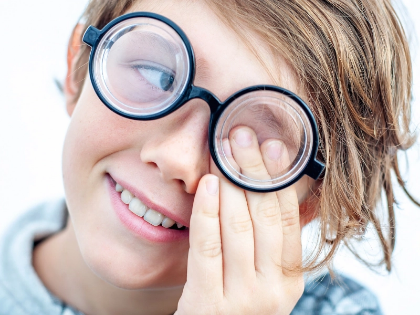What is maximum myopia?
Which type of myopia is strongest?Usually, myopia is a mild nuisance that can be quickly corrected with contact lenses or glasses. In certain people, degenerative myopia, also called pathological myopia, can worsen to the point of legal blindness. Sight-threatening conditions such as retinal holes, retinal tears, and choroidal neovascularization are also associated with high myopia. These disorders are caused by newly formed blood vessels leaking or bleeding into the retina. This is why frequent dilated vision tests are important.
Which myopia is highest?

What is the highest refractive error?
 Myopia, a refractive problem sometimes known as nearsightedness, impairs the ability to see distant objects clearly. It usually begins in childhood and can worsen over time until stabilizing between the ages of 20 and 30.
While severe myopia can cause more serious vision problems, mild myopia can be easily corrected with glasses or contact lenses. To prevent your myopia from getting worse, it's important to have regular dilated eye exams and adhere to your prescription.
High myopia increases the likelihood of developing diseases that can cause blindness, such as cataracts, glaucoma, and retinal detachment. This is because the abnormal elongation of the eyeball in high myopia can cause the retinal and vitreous tissues to stretch beyond their normal limits. This can result in symptoms such as floaters and an increased risk of retinal holes and tears, which can cause irreversible blindness.
Myopia, a refractive problem sometimes known as nearsightedness, impairs the ability to see distant objects clearly. It usually begins in childhood and can worsen over time until stabilizing between the ages of 20 and 30.
While severe myopia can cause more serious vision problems, mild myopia can be easily corrected with glasses or contact lenses. To prevent your myopia from getting worse, it's important to have regular dilated eye exams and adhere to your prescription.
High myopia increases the likelihood of developing diseases that can cause blindness, such as cataracts, glaucoma, and retinal detachment. This is because the abnormal elongation of the eyeball in high myopia can cause the retinal and vitreous tissues to stretch beyond their normal limits. This can result in symptoms such as floaters and an increased risk of retinal holes and tears, which can cause irreversible blindness.
What is the maximum axial length?
 High myopia (-6.00 D) can have many consequences, including retinal detachment, floaters, glaucoma, and cataracts. Thankfully, most people with this degree of myopia can lead normal lives and see well with the use of glasses or contact lenses. People with this degree of myopia should also have regular dilated eye exams to monitor for retinal tears or holes that can develop into full retinal detachment.
In one study, axial length in a cohort of 1877 adults increased by approximately 0.06 mm per year. Gender, baseline axial length, best-corrected visual acuity, and the presence of myopic maculopathy or previous choroidal neovascularization were all associated with severe axial elongation. According to this study, the development of extremely myopic eyes is a complex process, and factors that can be modified should be the primary focus of preventive measures. For example, vector A-scan/B-biometry is much more accurate in these long-term eyes than using ultrasound examination, which often provides anatomical information rather than refractive axial length, resulting in insufficient myopic IOL powers for patients.
High myopia (-6.00 D) can have many consequences, including retinal detachment, floaters, glaucoma, and cataracts. Thankfully, most people with this degree of myopia can lead normal lives and see well with the use of glasses or contact lenses. People with this degree of myopia should also have regular dilated eye exams to monitor for retinal tears or holes that can develop into full retinal detachment.
In one study, axial length in a cohort of 1877 adults increased by approximately 0.06 mm per year. Gender, baseline axial length, best-corrected visual acuity, and the presence of myopic maculopathy or previous choroidal neovascularization were all associated with severe axial elongation. According to this study, the development of extremely myopic eyes is a complex process, and factors that can be modified should be the primary focus of preventive measures. For example, vector A-scan/B-biometry is much more accurate in these long-term eyes than using ultrasound examination, which often provides anatomical information rather than refractive axial length, resulting in insufficient myopic IOL powers for patients.
Which ball equivalent is the highest?
 There is no consensus on the cutoff point for high myopia. Nevertheless, myopia is usually classified as high when more than 5 diopters of spherical correction are required. Due to the increased risk of blinding eye problems associated with high myopia, regular follow-up visits with your healthcare provider are very important.
Atropine is a useful long-term treatment for the progression of severe myopia in children. The rate of progression of spherical equivalent (SE) was significantly reduced and uncorrected distance visual acuity improved in most eyes during atropine therapy.
The authors used an autorefractive device to measure axial length and utilized cycloplegic retinoscopy to determine the sphere and cylinder of each eye. They found that the mean cylinder did not decrease significantly with age, whereas the mean sphere did. By the time they were 10 years old, five of eight eyes that were hyperopic on all retinal examinations had at least 3D hyperopia. However, two of these eyes had lost their hyperopia.
There is no consensus on the cutoff point for high myopia. Nevertheless, myopia is usually classified as high when more than 5 diopters of spherical correction are required. Due to the increased risk of blinding eye problems associated with high myopia, regular follow-up visits with your healthcare provider are very important.
Atropine is a useful long-term treatment for the progression of severe myopia in children. The rate of progression of spherical equivalent (SE) was significantly reduced and uncorrected distance visual acuity improved in most eyes during atropine therapy.
The authors used an autorefractive device to measure axial length and utilized cycloplegic retinoscopy to determine the sphere and cylinder of each eye. They found that the mean cylinder did not decrease significantly with age, whereas the mean sphere did. By the time they were 10 years old, five of eight eyes that were hyperopic on all retinal examinations had at least 3D hyperopia. However, two of these eyes had lost their hyperopia.











